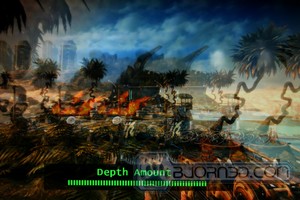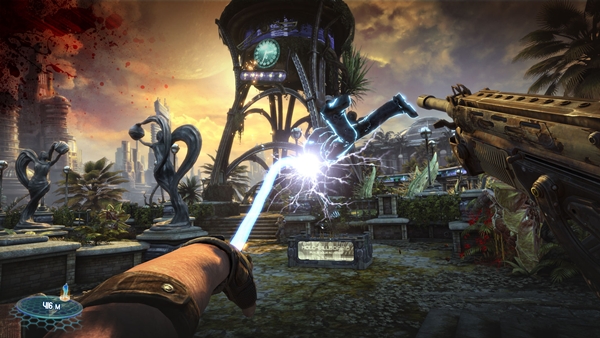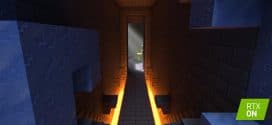Can you come up with the most creative ways to incite mayhem, cause destruction, and kill your enemies? If so, Bulletstorm will not disappoint you!
The highly anticipated first-person shooter Bulletstorm is finally here. It was released on February 22, 2011 in the US and on the February 24 and 25, 2011 in AU and UK respectively. Bulletstorm‘s development first started back in June 2007 with Epic Games and People Can Fly. Its incorporated skillshot gameplay system rewards players for being as creative and destructive as possible in their mayhem. Examples include killing enemies in midair, pushing enemies into man-eating plants, cactuses, walls and electricity, or executing enemies after violently transplanting bullets into their testicles. Games like the Serious Sam series and Gears of War closely resemble Bulletstorm in their penchant for violence and abundance of monsters and creatures. Players that enjoyed those games are more than likely to enjoy Bulletstorm, because it can be seen as a combination of the two, with more human-like realism in first-person shooter mode. Bulletstorm is a crazy and creative action game, allowing the user to have lots of fun slaughtering enemies and gaining combo points that will provide the options to upgrade weapons.
Running the well-known Unreal Engine 3, Bulletstorm is available on PC, Xbox 360, and PlayStation 3. However, considering that Bulletstorm was most likely developed for game consoles before the PC version, this could mean that PC gameplay could be limited for controls, graphics, and other features. Even so, after playing the game maxed out for a few hours, we did not ask for more.
The plot of Bulletstorm is rather simple and plain. The story felt quite weak and somewhat stupid compared to what we expected. Overall the story resembles Serious Sam in that that both have lots of toilet humor, and a story that sometimes drags on without any contribution to the plot whatsoever. Despite this, the constant upgrades and new skill points that users can earn throughout the game keeps the game fun and exciting to play. The story starts off with two lead characters including Grayson Hunt, the main character that the user ends up playing with throughout the whole game; Ishi Sato, Hunt’s partner in crime; and the addition of Trishka Novac, a hardcore woman of action. The story takes place in 26th century AD, where the safety and power of the planets is in the hands of the “Dead Echo” black ops army, which Hunt’s team was part of until a decision that lead to their discharge at the beginning of the game. Hunt’s team learned about the corruption of their leader General Sarrano, which has led to him getting revenge against Sarrano and his army 10 years after the main event. At this point Hunt’s unplanned actions cost his team their ship, which crash-landed on a planet called Stygia. There was only one thing they did not plan on: the conditions they had to battle through on the new planet, including Sarrano’s army which also landed on the same planet. Stygia is a planet full of dreadful monsters, criminals, and indescribable flesh eating plants that Hunt and Ishi need to battle through in order to save their lives.
The primary reason we found the story dull was due to the fact that the entire plot is revealed in the very beginning of the game, leaving nothing up to the imagination of the gamer. For those that like unexpected twists in the plot, this game might prove disappointing. However, the gameplay is extremely interactive and exhilarating, and for some, may compensate for the lack of solid plot. The presence of vulgar humor and profanities might be another turn-off for some gamers, and clearly is only suitable for mature audiences. While the vulgar expressions might steer some gamers away, the use of such vulgar expressions seems to fit the characters rather well. To be quite honest, even though we love to play games that have great stories, Bulletstorm did not dissapoint that much due to its constant scenes full of action, something rarely observed in first-person shooter video games. Whether it be avoiding a massive object rolling to crush the player into dust, or using the environment to smite one’s enemies with falling buildings and various other objects (this part we did not wish to spoil!), there are plenty of interactive elements that every gamer will find highly enjoyable.
After playing about two-thirds of the game, the novelty wore off, because we could tell just by looking at the surroundings exactly where we could kick or pull their enemies to; where we could throw them against the ground or against a giant meat eating plant; or where we could slam enemies between two objects to make yummy bloody sandwiches out of them. However, we are sure that gamers will not get bored of the surrounding and the environment they play the game in. It is constantly different and just looks gorgeous compared to other video games at this level of graphics. We’ll go into more detail about that on the next page.
Bulletstorm in 3D
On February 22, 2011, NVIDIA announced that Bulletstorm will be available with NVIDIA’s 3D Vision technology. The day Bulletstorm was released, Nvidia also had the latest 267.24 BETA driver up on their site enabling 3D Vision support for Bulletstorm along with additional performance improvements for other games. Last year, Epic Games and NVIDIA announced that they were working closely together to enable 3D Vision support on all of their upcoming games including Epic’s popular Unreal Development kit (UDK), a free version of Unreal Engine 3. We heard many good things about 3D Vision and wanted to give it a try as well. Nvidia was nice enough to hook us up with an ASUS VG236H 23″ 2ms 1920×1080 Full HD 120Hz 3D LCD Monitor with the NVIDIA 3D Vision Kit.
How NVIDIA’s 3D Vision Technology Works
The setup for the NVIDIA 3D Vision Kit was quite simple and only took about 5 minutes after we downloaded the Nvidia Drivers and the 3D drivers. After the installation, users need only enable the 3D Vision feature in the Nvidia drivers and go through a quick 1-2 minute setup. Once done, the Nvidia drivers automatically take care of enabling 3D mode once any 3D qualified game or application is started.The 3D feature can easily be enabled or disabled by pressing the combination CTRL + T. However, this does not completely enable or disable the 3D Vision technology in the drivers. This just temporarily enables or disables the duplication and rendering of the image on the 3D monitor.
The glasses that come with the NVIDIA 3D Vision Kit are special liquid crystal shutter glasses that most 3D enabled HDTVs use. This means that the glasses have built in electronics that control what users see through the glasses. The NVIDIA 3D shutter glasses have a liquid crystal layer which can easily be darkened when voltage is applied to it. The NVIDIA 3D kit communicates with an infrared transmitter that sends out information about the refresh rate of the monitor to provide information to the glasses on when each eye should alternately darken. The ASUS monitor we are using to test the 3D performance in Bulletstorm is using 120Hz refresh rate, which means that each eye on the shutter glasses will quickly darken and become transparent again about 60 times per second. When this is happening, the monitor is displaying two separate images on the screen using a technique called alternate-frame sequencing. The shutter glasses sync with the system and allow each eye to see only the proper side of the image displayed on the monitor from the two being rendered. This is what provides the stereoscopic image we call 3D.
It is important to understand that the 3D Vision technology has its good and bad qualities. This setup might not be for everyone, but we’ll share our experience about it to give our readers a better understanding of whether they should or should not invest into the technology. We also recommend giving the 3D experience a try at a local store like Fry’s Electronics, because most of the time they have a few systems set up to give users a chance to try 3D Vision. The problem with this though is that each application has its own 3D optimization, and some applications have better 3D support than others. Since NVIDIA worked closely with Epic Games to deliver great 3D experience, Bulletstorm will be exciting to try with 3D.
Bulletstorm With NVIDIA’s 3D Vision
Bulletstorm is definitely an excellent game for 3D due to the highly spacious 3D world the game is played in. Some great visual 3D effects are clearly seen through Hunt’s creative ways of killing his enemies. At the beginning of the game, Hunt finds a special device which allows him to pull enemies towards him with an electrical leash. This looks great in 3D since the user can clearly see the enemy flying closer in 3-dimensional space. In our opinion the best experience in 3D comes from the surrounding the game is played in. 3D environments like caves, tunnels, and 3D heavy scenes with tall buildings, plants, and objects provide for best possible 3D experience during gaming.
For those that have little or no experience playing games in 3D, the game does not resemble advertisements where the 3D image comes out of the monitor and surrounds the person. The objects do not necessarily pop out of the monitor. Instead the objects seem to go deeper within the monitor. It feels as if the monitor was very thick, and objects were placed in layers of differing depths, creating a 3-dimensional feel for the video game. The best possible explanation to describe the 3D experience is as if a person went to a nature museum and saw different environments with animals living behind a glass. The user can easily adjust the depth with the IR transmitter or with special keyboard shortcuts. It is important to understand that putting the depth settings to extreme can cause heavy strain on the user’s eyes. This can lead to severe headaches or make the user feel nauseated, so it is best to leave the 3D settings at comfortable levels.
We never experienced any bad 3D misrepresentations throughout the game, meaning that the two images that were displayed on the monitor always lined up to create a great 3D experience in Bulletstorm. Other games that do not have such high quality 3D experiences occasionally might separate throughout the game, and the user might start seeing double images of the same object as the eyes are not able to see the dual image representation in 3D. This can get quite annoying in FPS games when the crosshair in the middle of the monitor does not line up. Thankfully Bulletstorm had perfect 3D experience with NVIDIA’s 3D Vision technology.
4 Best 3D experiences to note in Bulletstorm:
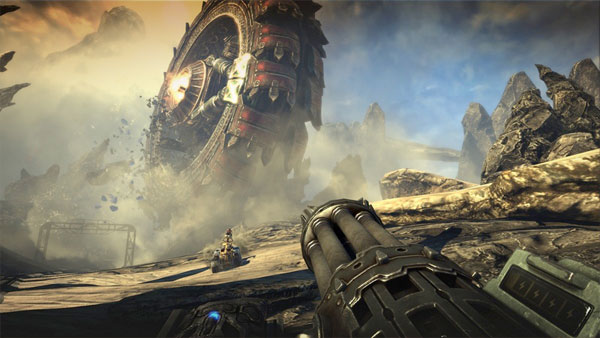
2. Our second favorite 3D experience was in a miniature museum in the game. The museum had several tall buildings representing a city. This environment in 2D was not as exciting since everything seemed to go together. Of course 2D depth was visible where the user would know where to go, but with 3D, the whole space in the museum turned into a large city. We could clearly see and get a sense for the height of each building and throw enemies against them, and it was one of our favorite 3D scenes in the game.
3. Levels with bosses or massive in-game objects, like the end of Act 3, and the beginning of Act 4 in the game are very exciting. In Act 3, Hunt, Ishi, and Trishka fight next to a large water mill which steadily deteriorates through the level. The end of Act 3 goes through lots of visual effects which makes it a fantastic experience in 3D. Act 4 has one of the most beautiful 3D urban environments we have seen, and overall the 3D experience is phenomenal.
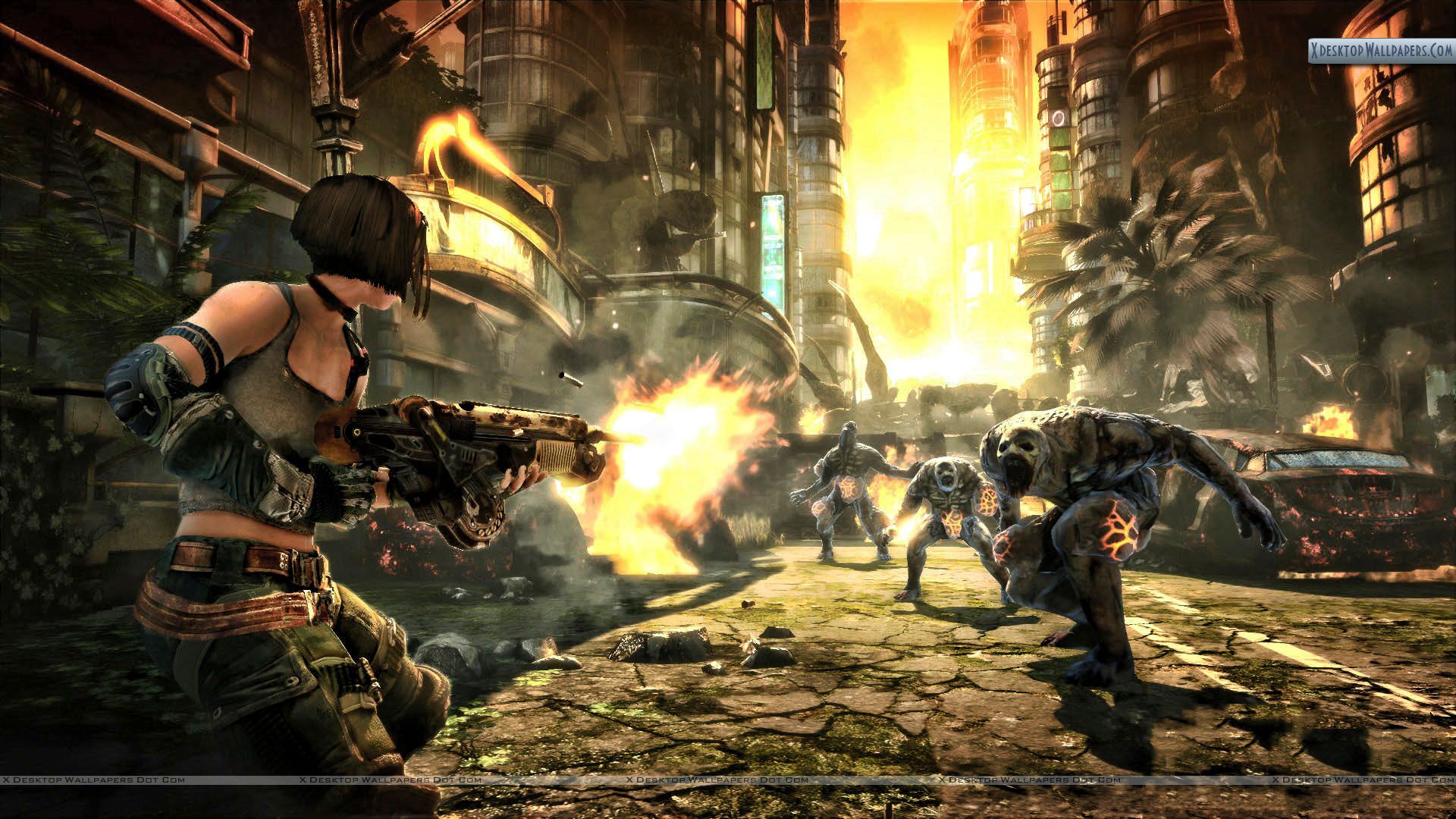
3 Things we did not enjoy with 3D Vision:
1. Because the user needs to use glasses that blink quickly by darkening the liquid crystals with the addition of voltage, the brightness of the monitor also fluctuates. The glasses work somewhat like sunglasses. 3D monitors usually provide extra brightness which tries to brighten up the gaming experience in 3D, though, we still felt that some scenes might have been slightly too dark with 3D Vision.

3. Finally, when playing in 3D, the presence of LEDs or any other lights in the room can be obnoxious. Sometimes, just the light coming from the window can cause a fluctuation and blinking through the shutter glasses, which can cause headaches and nausea. This is also very uncomfortable during gameplay because the user can constantly see blinking in his eyes. For our experience, it was best to disable the Logitech G15 keboard’s LCD and LEDs to prevent blinking caused by the back lighting.
Testing
To test the performance of Bulletstorm, we will run FRAPS and play the same part of the game several times to get an average reading for the graphics settings. We will use one system, our main gaming system which is described below in the specifications table. We will run the game at different resolutions and settings to address the system specifications for Bulletstorm. It is important to note that for some odd reason the game won’t render frames per second higher than 62FPS, even with VSync off. We believe this has to do with the fact that the game might have been moved from the gaming consoles to the PC.
Minimum System Requirements:
- Operating System Windows XP (SP3), Windows Vista (SP2), or Windows 7
- Processor Intel Core 2 Duo, AMD Athlon X2, or equivalent, running at 1.6 GHz or greater
- Memory (RAM) 1.5 GB
- HDD Space 9 GB available
- Video Card DirectX 9.0c compatible, 256 MB of VRAM; NVIDIA GeForce 7600 GS, ATI Radeon HD 2400 Pro 256 MB, or greater
- Soundcard DirectX 9.0c compatible, 16-bit
- Disc Drive 16X CD/DVD Drive
- Network Internet (TCP/IP) connection
Recommended System Requirements:
- Operating System Windows Vista (SP2), or Windows 7
- Processor QuadCore 2.0 GHz
- Memory (RAM) 2 GB
- HDD Space 9 GB available
- Video Card DirectX 9.0c compatible, 512MB of VRAM; NVIDIA GeForce GTX260, or ATI Radeon 4870
- Soundcard DirectX 9.0c compatible, 16-bit
- Disc Drive 16X CD/DVD Drive
- Network Broadband Internet (TCP/IP) connection
| Test Setup | |
| Case | Silverstone Temjin TJ10 |
| CPU |
Intel Core i7 2600K @ 4.6 GHz |
| Motherboard |
GIGABYTE P67A-UD7 |
| Ram |
Patriot Gamer 2 Series 1600 MHz Dual-Chanel 16GB (4x4GB) Memory Kit |
| CPU Cooler |
Heatblocker Rev 3.0 LGA 1156 CPU Waterblock Thermochill 240 Radiator |
| Hard Drives |
4x Seagate Cheetah 600GB 10K 6Gb/s Hard Drives 2x Western Digital RE3 1TB 7200RPM 3Gb/s Hard Drives |
| SSD | 1x Zalman SSD0128N1 128GB SandForce SSD |
| Optical | ASUS DVD-Burner |
| GPU |
2x Nvidia GeForce GTX580 in 2-Way SLI |
| Case Fans |
1x Quiet Zalman Shark’s Fin ZM-SF3 120mm Fan – Top 1x Silverstone 120mm fan – Front 1x Quiet Zalman ZM-F3 FDB 120mm Fan – Hard Drive Compartment |
| Additional Cards |
LSI 3ware SATA + SAS 9750-8i 6Gb/s RAID Card |
| PSU |
Sapphire PURE 1250W Modular Power Supply |
| Mouse | Razer Mamba |
| Keyboard | Logitech G15 |
| Monitor |
Asus VG236H 23″ 120Hz 3D Monitor (1920×1080) |
| Speakers | Logitech Z-2300 2.1 THX Certified Speakers |
Performance Addressed
Here are the frames per second we got after playing the middle of Act 4, Chapter 1 several times on different resolutions and settings:
| Resolution/Settings | Average Frames Per Second (Higher is Better) |
|---|---|
| 1920×1080, High in 3D, 8xAA |
46.5FPS |
| 1920×1080, High in 3D |
59.883FPS |
| 1600×900, High in 3D | 60FPS |
| 1280×720, High in 3D | 60FPS |
| 1920×1080, High, 8xAA | 55.8FPS |
| 1920×1080, High | 61.8FPS |
| 1600×900, High | 62FPS |
| Everything Bellow These Settings | 62FPS |
Here we have the results after we benched the game at the resolutions above. We can clearly see that the user can get smooth 46.5FPS performance even with the game completely maxed out in 3D mode. We can cap the performance for 3D at 1920×1080 on highest settings in 3D without any AA on. As long as the user is in 3D mode, the game will run up to 60FPS, but once 3D is turned off, the cap for FPS is at 62FPS. Some might think that it is due to VSync, but these results were taken after running the game with VSync off, both in-game, and in the Nvidia Drivers. We did some research online and it seems that this is an in-game cap for the frames per second, which can be hacked if the user can understand the information found in the game’s .ini file. Apparently it is not an easy file to understand and the user will have to mess around with it to unlock higher frames per second in the game.
We are sure a lot of high-end gamers will not like the cap, and eventually there might be an update available for the game which will enable higher frames per second. This also made us wonder why is there a built in VSync option if the game caps at 62FPS anyway.
Conclusion
For users who enjoy hordes of enemies, utter destruction, and wreaking absolute havoc, Bulletstorm is an excellent choice. While the story is lacking and rather short (only about 6-7 hours of gameplay), we found the overall experience favorable. We evaluated the experience in 2D and 3D, and found that the overall gaming experience was a lot more fun in 3D. It is important to note that a 3D setup is very expensive for users starting from scratch, and there are no guarantees as to whether or not users will feel sick or get a headache after using the shutter glasses that come with NVIDIA’s Vision 3D Kit.
The multiplayer portion of Bulletstorm is just as fun to play as the story mode as long as the gamer can come up with creative ways to kill enemies with their friends. We have expected to see a story mode in multiplayer which could be played with friends, but instead, multiplayer was developed into several closed levels in which gameplay is very limited. After a few hours of playing Anarchy mode, we lost interest.
The audio was fantastic in our opinion, and with our Logitech Z-2300 speakers, we felt quite involved in the game with the volume turned up. We also now have the Bulletstorm theme stuck in our head. Overall, for those looking for a new type of action first person shooter game, Bulletstorm should not disappoint.
| OUR VERDICT: Bulletstorm | ||||||||||||||||||||
|
||||||||||||||||||||
| Summary: Bulletstorm is a fun first-person shooter which will provide several hours of gameplay as long as you don’t go crazy at running through each level. By taking the time to explore new ways of killing your enemies,this game experience will not be forgotten, and can in fact become addicting enough seek out similar games on the market. For its fun factor and performance, we award it the Bjorn3D Silver Bear Award. |
 Bjorn3D.com Bjorn3d.com – Satisfying Your Daily Tech Cravings Since 1996
Bjorn3D.com Bjorn3d.com – Satisfying Your Daily Tech Cravings Since 1996














